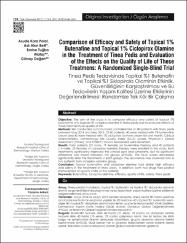Tinea Pedis Tedavisinde Topikal %1 Butenafin ve Topikal %1 Siklopiroks Olaminin Etkinlik, Güvenilirliğinin Karşılaştırılması ve Bu Tedavilerin Yaşam Kalitesi Üzerine Etkilerinin Değerlendirilmesi: Randomize Tek Kör Bir Çalışma
Abstract
Amaç: Tinea pedisli hastalarda topikal %1 butenafin ve topikal %1 siklopiroks olaminin etkinlik ve güvenilirliğinin karşılaştırılması ve bu tedavilerin yaşam kalitesi üzerine etkilerinin değerlendirilmesi amaçlandı.Yöntemler: Mayıs 2014 ile Mayıs 2015 tarihleri arasında, tinea pedisli 80 hasta üzerinde randomize kontrollü bir araştırma yapıldı. Bu 80 hastanın 40'ı topikal %1 butenafin krem, diğer 40'ı topikal %1 siklopiroks olamin krem ile bir ay süre ile tedavi edildi. Klinik özellikler, Dermatoloji Yaşam Kalite İndeksi (DLQI) skorları, Doktorun Global Değerlendirmesi (PhGA) ve Hastanın Global Değerlendirmesi kaydedildi.Bulgular: Butenafin tedavisi alan 40 hasta (21 erkek, 19 kadın) ve siklopiroks olamin tedavisi alan 40 hasta (15 erkek, 25 kadın) çalışmaya alındı. Her iki tedavi de klinik bulgu ve semptomları önemli derecede düzeltirken, gruplar arasında anlamlı farklılık saptanmadı (p>0,05). DLQI skorları her iki gruptaki tedavilerden sonra anlamlı olarak azaldı. Rekürrens sadece siklopiroks olamin grubundaki iki hastada gözlendi.Sonuç: Çalışmamızda tinea pedis tedavisinde topikal butenafin ve topikal siklopiroksolaminin benzer etkinlik, güvenilirliğe sahip olduğu saptanmıştır. Ayrıca yaşam kalitesi üzerine her iki ilaç benzer etkilere sahiptir. Objective: The aim of the study is to compare efficacy and safety of topical 1% butenafine and topical 1% ciclopirox olamine in tinea pedis and to evaluate effects of these treatments on quality of life.Methods: We conducted a randomized controlled trial on 80 patients with tinea pedis between May 2014 and May 2015. Of 80 patients, 40 were treated with 1% butenafine cream and 40 were treated with 1% ciclopirox olamine cream for one month. Clinical characteristics, Dermatology Life Quality Index (DLQI) scores, Physician's Global Assessment (PhGA), and Patient's Global Assessment were recorded. Results: Forty patients (21 male, 19 female) on butenafine therapy and 40 patients (15 male, 25 female) on ciclopirox olamine therapy were enrolled in the study. Both treatments significantly improved the clinical signs and symptoms, but no significant difference was found between the groups (p> 0.05). The DLQI scores decreased significantly after the treatments in both groups. The recurrence was observed only in two patients from ciclopirox olamine group. Conclusion: Topical butenafine and ciclopirox olamine had similar high efficacy and safety in the treatment of tinea pedis. In addition, both two drugs had positive improvement on quality of life of the patients.


















